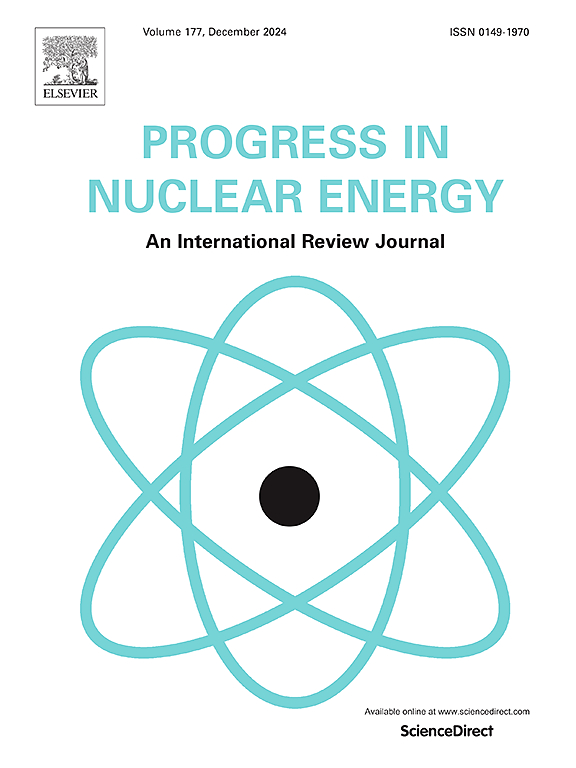The effect of copper oxide nanoparticles on the thermal behavior of silica aerogel/paraffin as a phase change material in a cylindrical channel with molecular dynamics simulation
IF 3.3
3区 工程技术
Q1 NUCLEAR SCIENCE & TECHNOLOGY
引用次数: 0
Abstract
The thermal conductivity of phase change materials was substantially enhanced by nanoparticles, improving the overall performance of thermal energy storage systems through more efficient heat transfer during the phase change process. This study investigates the effect of varying amounts of copper oxide nanoparticles on the thermal behavior of silica aerogel/paraffin as a phase change material in a cylindrical channel. LAMMPS and molecular dynamics simulations were employed to analyze this using a computer program. Results show that the atomic sample density and velocity reached 0.1393 ų and 0.0119 Å/fs, respectively, with the addition of 5% nanoparticles to the target structure. The atomic samples also reached a maximum temperature of 635 K when 5% of nanoparticles were added. The heat flux and thermal conductivity increased from 66.43 W/m2 and 1.74 W/m·K to 71.25 W/m2 and 1.82 W/m·K with a CuO-NP concentration increase of 3%. Adding nanoparticles enhanced thermal conduction, improving the overall interaction between the PCM and the nanoparticles. This led to better thermal contact and reduced thermal resistance at interfaces. However, adding more nanoparticles may lead to agglomeration, where the nanoparticles cluster together instead of remaining evenly dispersed. This can negatively affect thermal properties, as agglomerated particles create larger voids in the material, reducing the effective contact area for heat transfer. Using molecular dynamics simulations provided valuable insights into optimizing nanoparticle concentration for improved thermal performance in energy storage applications.
求助全文
约1分钟内获得全文
求助全文
来源期刊

Progress in Nuclear Energy
工程技术-核科学技术
CiteScore
5.30
自引率
14.80%
发文量
331
审稿时长
3.5 months
期刊介绍:
Progress in Nuclear Energy is an international review journal covering all aspects of nuclear science and engineering. In keeping with the maturity of nuclear power, articles on safety, siting and environmental problems are encouraged, as are those associated with economics and fuel management. However, basic physics and engineering will remain an important aspect of the editorial policy. Articles published are either of a review nature or present new material in more depth. They are aimed at researchers and technically-oriented managers working in the nuclear energy field.
Please note the following:
1) PNE seeks high quality research papers which are medium to long in length. Short research papers should be submitted to the journal Annals in Nuclear Energy.
2) PNE reserves the right to reject papers which are based solely on routine application of computer codes used to produce reactor designs or explain existing reactor phenomena. Such papers, although worthy, are best left as laboratory reports whereas Progress in Nuclear Energy seeks papers of originality, which are archival in nature, in the fields of mathematical and experimental nuclear technology, including fission, fusion (blanket physics, radiation damage), safety, materials aspects, economics, etc.
3) Review papers, which may occasionally be invited, are particularly sought by the journal in these fields.
 求助内容:
求助内容: 应助结果提醒方式:
应助结果提醒方式:


